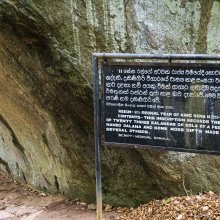Kalanda, Kalamda: 4 definitions
Introduction:
Kalanda means something in Hinduism, Sanskrit, Buddhism, Pali, Marathi, Jainism, Prakrit. If you want to know the exact meaning, history, etymology or English translation of this term then check out the descriptions on this page. Add your comment or reference to a book if you want to contribute to this summary article.
Images (photo gallery)
Languages of India and abroad
Pali-English dictionary
Source: Sutta: The Pali Text Society's Pali-English DictionaryKalanda, (cp. Sk. karaṇḍa piece of wood?) heap, stack (like a heap of wood? cp. kalingara) Miln. 292 (sīsa°). (Page 198)

Pali is the language of the Tipiṭaka, which is the sacred canon of Theravāda Buddhism and contains much of the Buddha’s speech. Closeley related to Sanskrit, both languages are used interchangeably between religions.
Marathi-English dictionary
Source: DDSA: The Molesworth Marathi and English Dictionarykalaṇḍā (कलंडा).—a (kala) Lying over; inclining or resting on one side.
Marathi is an Indo-European language having over 70 million native speakers people in (predominantly) Maharashtra India. Marathi, like many other Indo-Aryan languages, evolved from early forms of Prakrit, which itself is a subset of Sanskrit, one of the most ancient languages of the world.
Prakrit-English dictionary
Source: DDSA: Paia-sadda-mahannavo; a comprehensive Prakrit Hindi dictionaryKalaṃda (कलंद) in the Prakrit language is related to the Sanskrit word: Kalanda.
Prakrit is an ancient language closely associated with both Pali and Sanskrit. Jain literature is often composed in this language or sub-dialects, such as the Agamas and their commentaries which are written in Ardhamagadhi and Maharashtri Prakrit. The earliest extant texts can be dated to as early as the 4th century BCE although core portions might be older.
Sanskrit dictionary
Source: DDSA: Paia-sadda-mahannavo; a comprehensive Prakrit Hindi dictionary (S)Kalanda (कलन्द) in the Sanskrit language is related to the Prakrit word: Kalaṃda.
Sanskrit, also spelled संस्कृतम् (saṃskṛtam), is an ancient language of India commonly seen as the grandmother of the Indo-European language family (even English!). Closely allied with Prakrit and Pali, Sanskrit is more exhaustive in both grammar and terms and has the most extensive collection of literature in the world, greatly surpassing its sister-languages Greek and Latin.
See also (Relevant definitions)
Starts with: Kalamdani, Kalanda kakunze, Kalanda Vihara, Kalandagama, Kalandaja, Kalandaka, Kalandakagama, Kalandakanivapa, Kalandakaputta, Kalandana, Kalandanem, Kalandar, Kalandara, Kalandavinem.
Ends with: Sisakalanda.
Full-text: Kalanda kakunze, Sisakalanda, Kalayanakannika, Kalandakaputta, Bamboo Grove, Kalandanem, Kalanda Vihara, Rajagaha, Ghata Sutta, Kalandakanivapa, Mahadathika Mahanaga.
Relevant text
Search found 9 books and stories containing Kalanda, Kalaṇḍā, Kalamda, Kalaṃda; (plurals include: Kalandas, Kalaṇḍās, Kalamdas, Kalaṃdas). You can also click to the full overview containing English textual excerpts. Below are direct links for the most relevant articles:
The Great Chronicle of Buddhas (by Ven. Mingun Sayadaw)
Chapter 31 - The Monk Sudinna, the Son of the Kalanda Merchant < [Volume 4]
Part 1 - The story of Sudinna (the Kalandaka merchant’s son) < [Chapter 31 - The Monk Sudinna, the Son of the Kalanda Merchant]
Settlement in Early Historic Ganga Plain (by Chirantani Das)
Part 10 - Water-Drainage System (regarding Rājagṛha) < [Chapter I - The Case Study of Rājagṛha]
Guide to Tipitaka (by U Ko Lay)
(b) When And How The Disciplinary Rules Were Laid Down < [Chapter I - What Is Vinaya Pitaka?]
Mahavamsa (by Wilhelm Geiger)
Dipavamsa (study) (by Sibani Barman)
A Short history of Lanka (by Humphry William Codrington)

